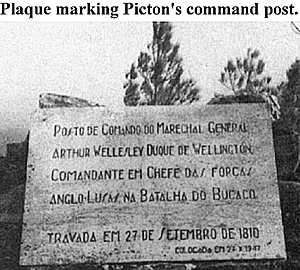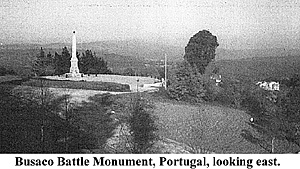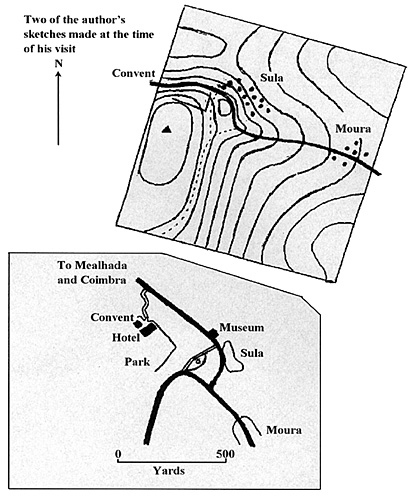Given the opportunity to visit the place, I resolved to do so. Approaching from Coimbra, your eye is drawn to high places seeking out this formidable ridge. I only spotted it when almost upon it, already climbing up from Mealhada. Winding through a pleasant park, divided up into scenic areas with names vaguely reminiscent of the British generals, you come across the convent, now a splendid hotel, swallowed up by King Ferdinand's palace (also a hotel). Amidst this Five Star glory, you can wander about in its tiled decor, gazing up at the nice wall hangings, weapons from the era, stumble over cunningly laid piles of cannonballs, and finally recoil when you spot the Bed & Breakfast prices.
There is a small room where Wellington slept, and an olive tree which he is supposed to have planted shortly before the retreat commenced.
Musuem
A short drive away up the road, takes you past the small but interesting museum sited adjacent to a small chapel, the sight of the British hospital at the battle. Highly polished relics such as pistols and swords lie in glass cases, and -- Portuguese artillery, gun and team, are displayed in the main hall. Some of the maps on the wall are worth studying, as the detail is marvellous. If the annual 'reenactment' by the Portuguese Army still takes place on the Anniversary, I could find nor ascertain any trace of it.
Legend here has it that Crauford spent the time before the battle creeping about in an old windmill, and peering out from behind a large rock, both of which carry small plaques to this effect. What you do get from the windmill is an appreciation that Massena must have had a pretty small opinion of the enemy to send troops up those slopes to attack an excellent defended position. The trees weren't there at the time, and the French moves would have been easy to follow from the higher observation points.
False Summit
Although it isn't far from Sula, the starting point, the poor French infantry must have been out of breath by the time they reached anywhere near the 'false' summit, from where they were suddenly riddled with bullets. Another road splits off above Sula, and travels along the ridge top for miles. A stone, marking one of Wellington's observation posts, stands alone just off the road in the thick forest. I could find no sign of Wellington's lateral road, nor the road to Palheiros or San Antonio de Cantara.
The trees obscure most of the view, but if you fight your way through to the place where Reynier's Corps attacked, the slopes are precipitous in places, and this must have been a very slow and steady advance. The hillside is split in several places by small ravines and gullies, and you can imagine small groups of voltigeurs clambering up them and finding themselves within British positions, but unsupported and vulnerable.
The ridge is just too overgrown and forested to make it a place where you could find your way around and make a good map for yourself. Because of the trees, you don't always get the feeling you are quite high up with commanding views.
Wandering
If you get the chance or have the time, wander down into Sula and Moura - a lot of houses are period, and the occupants will point out bullet scars and bullet strikes on the walls.
I wouldn't dispute any of the available maps in books - without a helicopter I couldn't do better. I enclose a small sketch of 'modern' Bussaco for perusal instead, made at the time and copied from my notebook.
I couldn't spot a position for French artillery - anywhere on the area occupied by Ney's Corps is tough going for gun teams. Allied riflemen on the slopes east of Sula must have had some easy shots with their rifles at soldiers toiling up toward them.
South of Moura, the ground is even worse for French guns. Placing guns on the few areas of flattish ground would mean great care would have to be taken as your own troops would of necessity soon climb up in front of your battery, even if you could get the elevation to reach a target. Such is the state of things at Bussaco....
As a wargame project - stick to Fuentes or Salamanca!
 I took part in a wargame "Bussaco" some years ago - the terrain was such that the French commander had to be decided by drawing straws. In our game, the French struggled as much with the ter-rain as with, eventually, enemy fire.
I took part in a wargame "Bussaco" some years ago - the terrain was such that the French commander had to be decided by drawing straws. In our game, the French struggled as much with the ter-rain as with, eventually, enemy fire.
 Another short march of 250 yards brings you to the monument itself, a pillar topped with a blue star, on a flat plateau ringed with upturned cannons (some of which appear, curiously, to be naval guns). The star, which used to be turned on to mark the anniversary, is now a shadow of it's former self, being the target for every lout that can find a stone or pebble. A good view over the surrounding country to the east can be had from here. To the right is the road which drops down into Sula, and behind you the site of artillery pieces, beyond that, the area occupied by Crauford's troops.
Another short march of 250 yards brings you to the monument itself, a pillar topped with a blue star, on a flat plateau ringed with upturned cannons (some of which appear, curiously, to be naval guns). The star, which used to be turned on to mark the anniversary, is now a shadow of it's former self, being the target for every lout that can find a stone or pebble. A good view over the surrounding country to the east can be had from here. To the right is the road which drops down into Sula, and behind you the site of artillery pieces, beyond that, the area occupied by Crauford's troops.

Back to Table of Contents -- First Empire #20
Back to First Empire List of Issues
Back to MagWeb Master Magazine List
© Copyright 1995 by First Empire.
This article appears in MagWeb (Magazine Web) on the Internet World Wide Web. Other military history articles and gaming articles are available at http://www.magweb.com